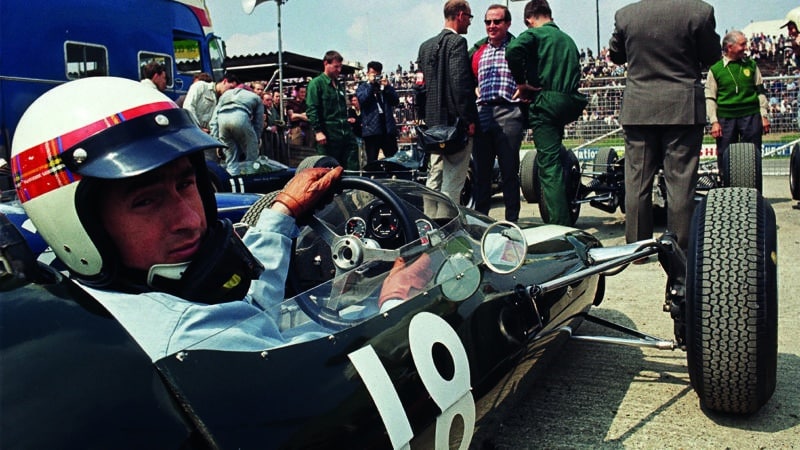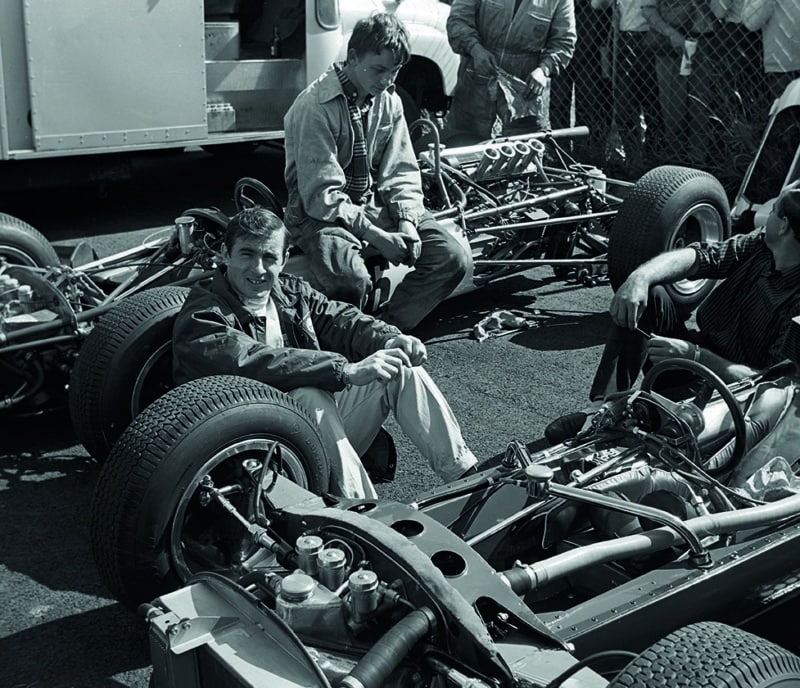Chapter Three - Formula 2 and 3
Originally destined to shoot for the stars in a different sport, fate had other ideas for Stewart. A chance offer led to a starting point in racing, says Paul Fearnley, which snowballed into launching one of the all-time great careers, both in and out of grand prix racing

Shortly before his 26th birthday, Stewart sits in Ken Tyrrell’s F2 Cooper T57 during the 1965 London Trophy meeting at Crystal Palace. Jim Clark (Lotus 35) won from Graham Hill (Brabham BT16); Stewart retired with a broken halfshaft
Young Jackie Young Stewart was a hotshot long before he became a hotshoe: shattering clay pigeons rather than lap records; squeezing triggers rather than blending brake and throttle. Giving it both barrels with a single mind was where this undiagnosed (until 1980) dyslexic learned how to learn: how to eradicate error by removing hazard and risk; how to block out the extraneous; and how to win. Motor sport underscored Stewart’s formative years rather than overwhelmed them. The family garage/petrol station/dealership on the A82/A814 junction between Glasgow and Loch Lomond was a fulcrum of a small but ultimately hugely influential local speed scene. Brother Jimmy, his elder by eight years, had been a driver for Ecurie Ecosse initially and then aboard works Astons and Jaguars; wee Jackie was his autograph-hunting number one fan.
But Jimmy’s premature retirement in 1955 after big accidents at Le Mans, the Nürburgring and Silverstone left 16-year-old mechanic Jackie minding a spotless lubrication bay during the week and shooting for national and international trophies at weekends. His selection for Great Britain at the 1960 Rome Olympics seemed assured. The shock of his missing this cherished target by a single point would prove transitional.
Well-to-do Barry Filer was one of the garage’s sporting clientele and his out-of-the-blue offer of a Porsche Super 90 for a local sprint set Stewart upon a new path: he finished second. He further proved his talent at Oulton Park by lapping an E-type ‘demonstrator’ faster than the presumably better-tuned sister cars of Graham Hill and Ray Salvadori. As a result, he would soon be winning regularly at Berwickshire’s Charterhall in Filer’s ‘wooden wonder’ Marcos and DB4 GT.
The wins continued in 1962 – but ‘Mother Stewart’ was deeply unimpressed after a local newspaper had blown her youngest’s cover. This ‘other’ Mr Stewart was, according to a caption accompanying a photograph of his marriage to Helen McGregor (in August), a racing driver rather than a shooter. Despite all the subsequent wins and championships, maternal recognition would never be forthcoming.

Stewart in the paddock at Karlskoga, Sweden, during the 1965 Kanonloppet F2 meeting. He qualified his Tyrrell Cooper fifth, but failing oil pressure forced him to retire in the race’s early stages. Jack Brabham and Denny Hulme took a 1-2 in their Brabham BT16s
Signed by David Murray’s iconic Ecurie Ecosse for £500 and 50% of winnings and bonuses, Stewart’s (real) name and reputation crossed the border. By September it had reached as far south as Goodwood, where his setting a fastest lap in a Cooper Monaco caught the eye of track manager Robin Mackay, who in turn had the ear of Ken Tyrrell: a test of the latter’s new F3 Cooper at the circuit was proposed for March 1964. The canny Stewart wasn’t convinced by the thought of driving a single-seater – until he spoke with another garage visitor, who just happened to be the reigning world champion: Jim Clark advised him to take this chance to progress.
Stewart was not to know that he had lapped quicker than Bruce McLaren until the end of the day, but must have guessed that he was doing something right when, after just a handful of laps, a spectating John Cooper galloped back to the pits shouting, “You’ve got to sign him!” Stewart made a winning F3 debut the following weekend – he was leading by 48sec after just three soaking laps of Snetterton!
Stewart won 10 of his 11 F3 races that season, including the prestigious Monaco Grand Prix support race by a handsome margin, for which Juan Fangio congratulated him warmly. Suddenly the telephone, ‘manned’ by whip-smart Helen, was ringing off the hook: John Coombs, Graham Warner of The Chequered Flag and Colonel Ronnie Hoare of Maranello Concessionaires paid Stewart to drive ‘Lightweight’ E-types, Elans and Ferrari 250LMs; and he was competitive in all.
By July he was making his Formula 2 debut in a semi-works Lotus: he finished second at the daunting Clermont-Ferrand circuit. By August he was winning in a Ford Lotus Cortina in the United States. His ascent to F1 was assured, but with whom?
The persuasive Colin Chapman went so far as to arrange a special test of an F1 Lotus at the British GP; Stewart missed a gear and spun. But BRM – more perspiration than inspiration – had made an approach a fortnight earlier. He preferred its offer of stability and reliability for 1965. Plus, history suggested being number two to Clark at Lotus was a fool’s errand.
Though Stewart would make his F1 debut with Team Lotus in December – as replacement for Clark, who had cricked his back in an Italian snowball fight! – and though its car proved significantly better than the BRMs, he saw no reason to regret his decision. Yes, he won the second part of Kyalami’s Rand GP from the rear of the field, but he did so only after his pole position for the first had been squandered by a driveshaft failure on the grid. He felt sure that he would learn about himself and his place in the sport more quickly at BRM. Already he had proved himself astute both in and out of cockpit.
